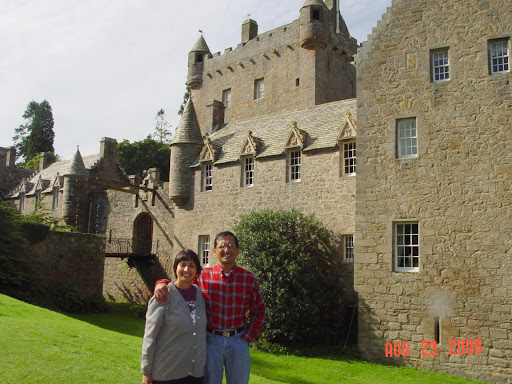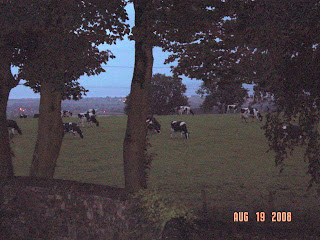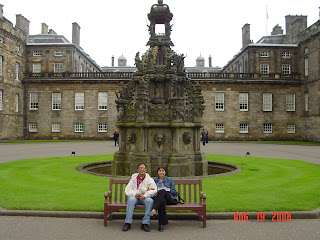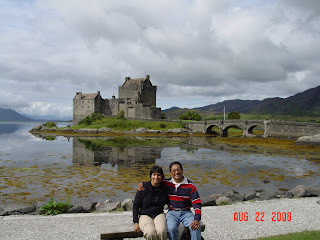A Look at More Fairy-Tale Castles
Outside Shakespeare’s Cawdor Castle
After breakfast in Inverness the next morning, we headed for Aberdeen but decided to stop en route to see some of the more interesting sites on the 106 mile journey.
Cawdor Castle–Setting of Shakespeare’s ‘Macbeth’:
Our first stop was Cawdor Castle, popularized by Shakespeare’s Macbeth but bearing little or no historical accuracy with the real events that led to the grizzly happenings of the play. Paying £4 each to tour the grounds and the gardens (we chose to pass on the interiors for want of time), we spent about an hour just taking in the magnificence of it all.
The castle has been beautifully refurbished to keep up with the huge tourist interest in it. For the half price we paid, we saw the stone exterior which was very impressive indeed, crossed the grass-filled moat to the entrance and I even had a peep into the interior which was furnished rather opulently in typical English-country style.
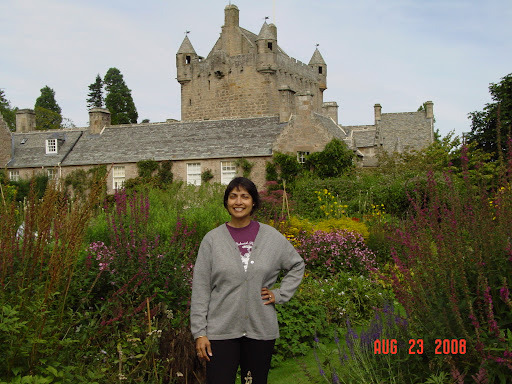 Cawdor has a spacious maze and we had a peak at that as well before we made our way into the spectacular gardens (left)that were just full of autumnal blooms and I saw my very first blooming thistle for the first time in Scotland. Lavender was everywhere as were Asiatic lilies and rows and rows of a dropping white flower that I couldn’t recognize. We took so many pictures with the castle in the background and I found it hard to believe that I was actually in the venue of which I had read when I was in my teens—Cawdor Castle. I actually saw a bubble hole and a cauldron at the very entrance to the castle that was reminiscent of the first lines of the play–Macbeth.
Cawdor has a spacious maze and we had a peak at that as well before we made our way into the spectacular gardens (left)that were just full of autumnal blooms and I saw my very first blooming thistle for the first time in Scotland. Lavender was everywhere as were Asiatic lilies and rows and rows of a dropping white flower that I couldn’t recognize. We took so many pictures with the castle in the background and I found it hard to believe that I was actually in the venue of which I had read when I was in my teens—Cawdor Castle. I actually saw a bubble hole and a cauldron at the very entrance to the castle that was reminiscent of the first lines of the play–Macbeth.
Double Double, Toil and Trouble
Fire Burn and Cauldron Bubble.
Over to Elgin:
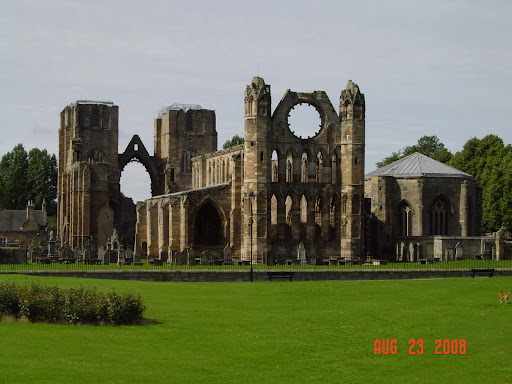 Our drive took us further on to the seaside town of Nairn past a very small and very appealing country road—almost a bike pathway–before we caught the main roadway again and headed to the medieval town of Elgin which has a 13th century Town Center with cobbled streets and old stone cottages—just very beautiful. It also has a 13th century ruined cathedral which made some lovely pictures. We had a fantastically sunny day which was such a relief after all the clouds and drizzles we’ve passed through in the past week. But then my guidebook informed me that Elgin is the sunniest town in the entire UK and is known for its bright blue skies!
Our drive took us further on to the seaside town of Nairn past a very small and very appealing country road—almost a bike pathway–before we caught the main roadway again and headed to the medieval town of Elgin which has a 13th century Town Center with cobbled streets and old stone cottages—just very beautiful. It also has a 13th century ruined cathedral which made some lovely pictures. We had a fantastically sunny day which was such a relief after all the clouds and drizzles we’ve passed through in the past week. But then my guidebook informed me that Elgin is the sunniest town in the entire UK and is known for its bright blue skies!
Well, just as we were about to leave the cathedral precincts, I spied a sign that announced Johnstons of Elgin Visitor Showroom and I told Llew that I wanted to visit it. This is because I am familiar with their products and love them dearly having used a 100% lambswool throw made by them which I bought over 10 years ago. Since we are decorating our new media room, it made sense for me to consider purchasing another throw for the new space. How delighted I was to explore the environs of this century-old showroom in the very place where the local sheep provide the wool that makes those luxurious items. Of course, we did find a throw that would suit the colors of our room and for a very affordable price –just £30 for a lambswool throw in a very bold plaid—in keeping with the plaid designs of Scotland–a very fitting souvenir indeed of a country that is filled with sheep at every turn!
Homeless in Aberdeen!
Back on the road, we drove through very gentle glens towards Aberdeen. There were very charming villages along the way, some no more than a single street with a few old stone cottages along the road, others complete with churches and greens and bridges. When we did arrive in Aberdeen, we tried to find ourselves accommodation for the night as this was the only place in which I did not succeed in finding a room before our departure from the US. Well, everything in Aberdeen was chocobloc and we could find nothing. We did walk the length of two streets for about an hour trying to find something but drew a blank. Finally, I suggested to Llew that we should start driving along the Royal Deeside (i.e. along the banks of the River Dee) and that we should keep our eyes open for any possibilities of B&Bs along the way.
To follow us on the next leg of our travels, please click on the link for the Royal Deeside Tour.
